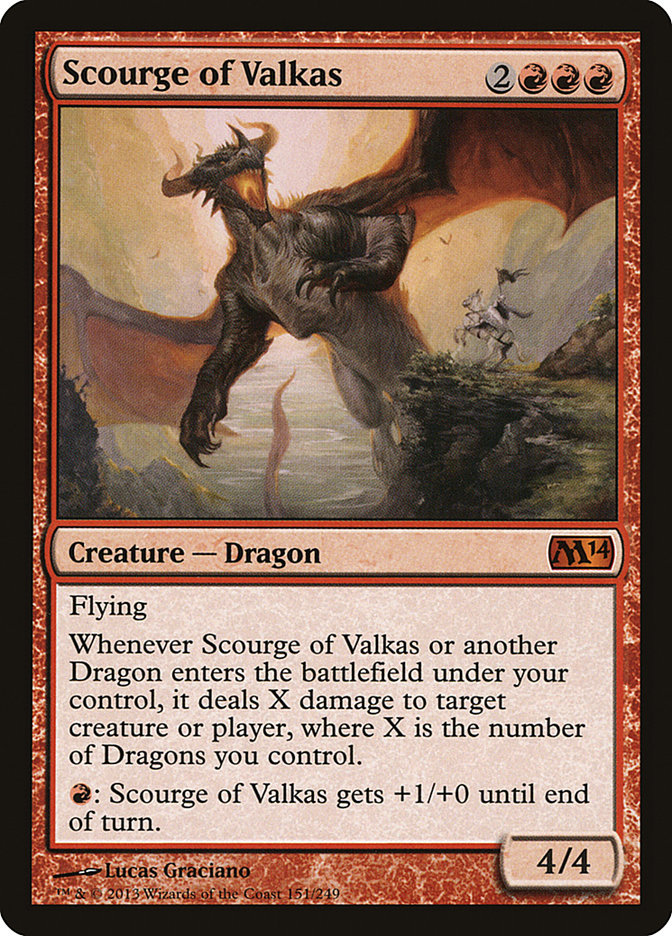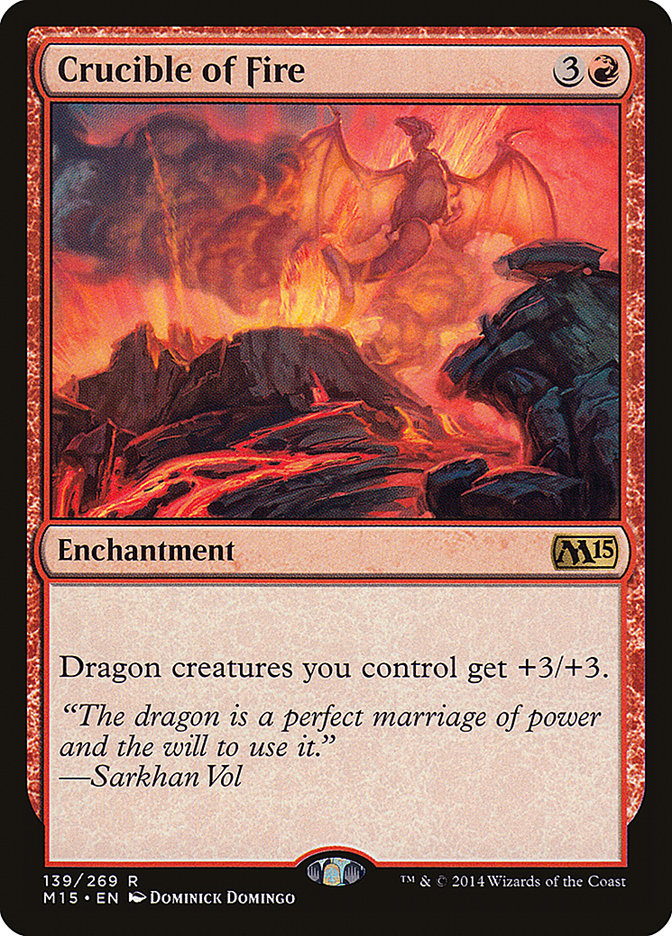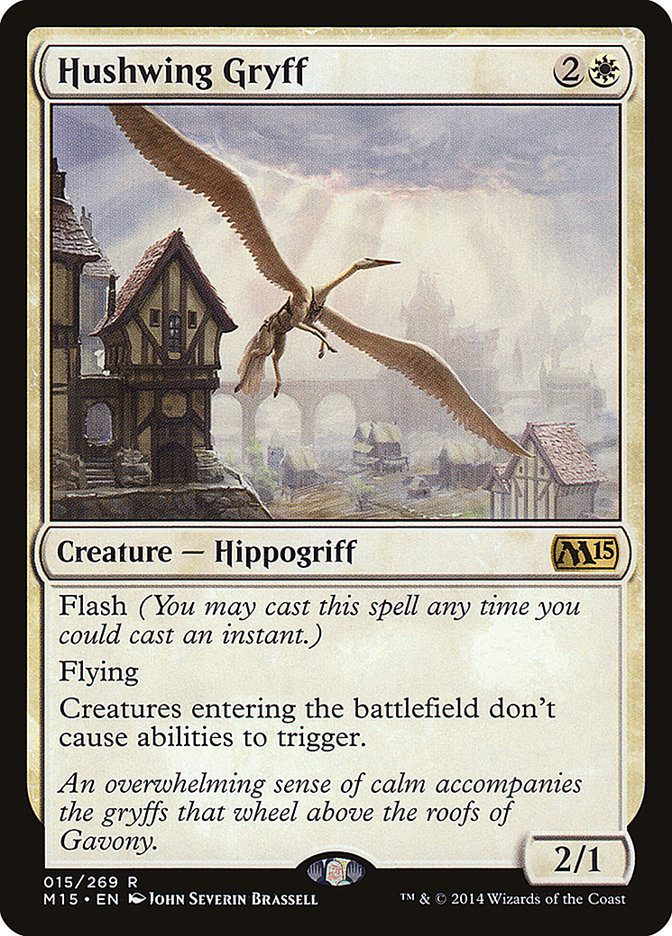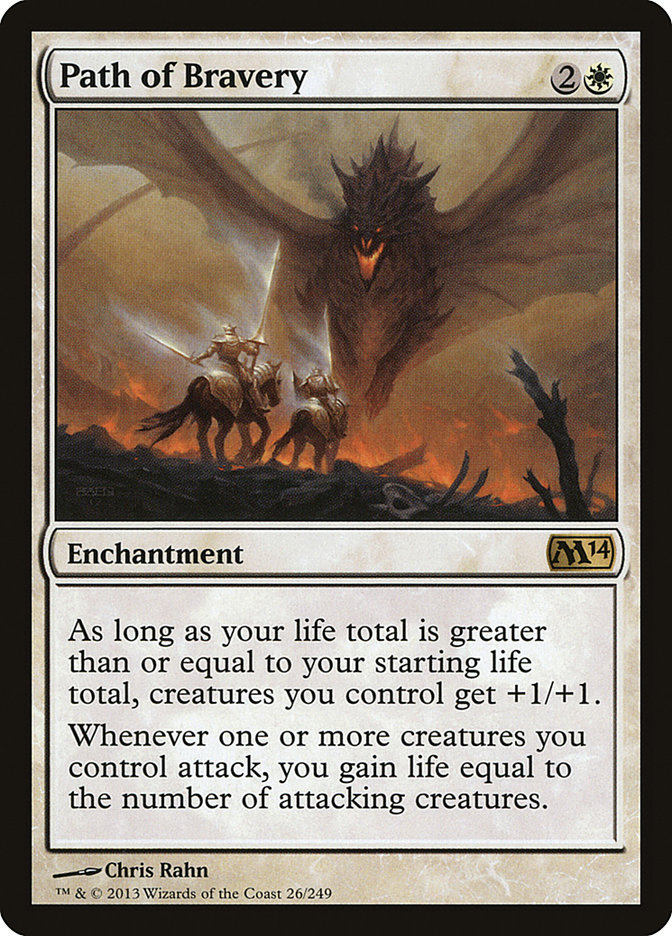If you were given any superpower, chances are you’d want to fly.
Something about soaring through the air makes us feel young and free. It’s something we’ve been drawn to throughout human history, ever since we saw a bird
first cut the surly bonds of earth. Some love the simple joy of flying, looking at the clouds and the rolling hills and plains below, and they find it
peaceful and relaxing. Others enjoy flying as a means to end, to travel from one destination to the other and see new places. Many don’t care for flight at
all, preferring the safety and reliability of being on stable land over flying in a newfangled contraption through the air at close to the speed of sound.
Some, however, see flight as a form of dominance.
It’s not hard to see why; flying uninhibited over terrain once thought impassible can give you a huge advantage. In Magic, we know that’s true too, and few
creatures define this advantage better than dragons.
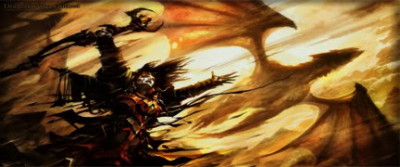
These powerful, flying lizards are a staple in Magic lore, and wielding their power is thrilling. From a practical perspective, there is rarely as
efficient a monster as a raging, fiery dragon; Thundermaw Hellkite remains one of the most fearsome ways to spend five red mana. Thankfully, there are lots
of exciting Dragons in Standard, and one of M15’s new cards includes a card designed to serve the need of fast, powerful Dragons.
In my mind, this is one of the most exciting commons in M15. Being able to ramp and give the creature haste puts you three turns ahead in
some cases. Sure, you could a resolve a five-drop without haste, but giving it haste adds a lot of value to the Servant.
Generator Servant isn’t all that new; cards in this same vein have existed before, and one just so happens to exist in Standard in the form of Satyr
Hedonist. Now that we have more than one way to do this three-to-five ramp, casting awesome Dragons should be much easier.
Creatures (24)
- 4 Burning-Tree Emissary
- 4 Scourge of Valkas
- 4 Satyr Hedonist
- 4 Stormbreath Dragon
- 1 Xenagos, God of Revels
- 4 Generator Servant
- 3 Siege Dragon
Planeswalkers (6)
Lands (24)
Spells (6)
Sideboard

Here, our plan is to resolve one of two Dragons on turn 3, follow it up with a planeswalker, then flatten your opponent with a ramped-up Mizzium Mortars.
As your Dragons are screaming across the sky, your opponent will be resolving their first Pack Rat.
Creatures
Burning-Tree Emissary and Nykthos, Shrine to Nyx team up for 5729th time, but the Shaman also has the added benefit of very effectively fixing
your mana, allowing you to cast either three-to-five ramp creature off its trigger regardless of the land base. Generator Servant and Satyr Hedonist
perform similar but not identical functions. Satyr Hedonist can keep you heavy on red mana in case you had an awkward Stomping Ground/Nykthos draw, while
Generator Servant provides the push to force one of your largest creatures into a speedy brawl. Both also function as a way to ramp for auxillary spells;
if you have some red mana, you can Mizzium Mortars on four, for example, or you can eke out a planeswalker on a lousy two-land keep. Both also power a
Nykthos activation, and if you’re going for red devotion, you can sacrifice the Hedonist without reducing your devotion count.
Stormbreath Dragon doesn’t need haste added to it; it’s already a house and sees plenty of play besides. If you are able to ramp it out, your next
three-to-five ramp creature (I’ll call them “ritual creatures” after Pyretic Ritual and friends) could push through its monstrous trigger. If it’s coming
down earlier, chances are you’ll be hitting them while their hand is still large. Scourge of Valkas, a largely forgotten red Dragon, works well in a shell
that includes both its own creature type and Nykthos, Shrine to Nyx, as it pays red’s fare by itself. Moreover, if you ramp this out with Generator
Servant, it is a Thundermaw Hellkite, as it deals four damage plus one from its trigger. Later in the game, Scourge can deal significantly more
damage, and in multiples they deal damage exponentially. As icing on the cake, it has firebreathing, letting it take any extra Nykthos mana you generate
and funneling it into your opponent’s face.
Siege Dragon is perhaps the most exciting inclusion. Siege Dragon with haste is light years better than Siege Dragon without haste, as it’s a one-sided
Pyroclasm the moment it turns sideways. By itself, it devours Elspeth, Sun’s Champion and even a ticked-up Jace, Architect of Thought. The Wall clause is
irrelevant most of the time, but it might snag a Wall of Frost or Wall of Mulch on occasion, if that deck becomes
possible
popular. Finally, one “Xenagod,” Xenagos, God of Revels adds an extra level of haste potential. Every Dragon gets infinitely better with haste, and adding
a few points of power never hurt. In the nuts multiple-Emissary draw, this can land as a creature off Generator Servant, attack, and bring a 4/4 Emissary
with it.
Spells
A full set of Mizzium Mortars seems ideal for this deck. Not only is the mana production insane, it can be cast off an Emissary trigger or a ritual
creature.
Chandra, Pyromaster and Xenagos, the Reveler both play into the deck’s plan too. The deck lacks card draw and suffers some card disadvantage from its
ritual creatures. Chandra helps keep you on parity by giving you an extra card each turn, or it can snipe a flying blocker so you can rumble in with your
freshly cast Dragon. In my opinion, Chandra, Pyromaster is one of the deck’s best tools against a control deck. Supreme Verdict runs rampant and without a
way to stop it, this deck has to, well, go over top of it. Having two cards a turn will help get you there. Xenagos provides you mana for the turn after he
resolves. I think it will be easy to use his +1 ability, sack your ritual creatures, and churn out one or two Dragons in one turn. Hammer of Purphoros
offers devotion and, as stated earlier, makes every Dragon hasty, providing immense value with each monstrous flyer.
Lands
This deck is primarily red, so that’s where the land focus lies, with no room for Mutavaults or utility lands outside of Nykthos, Shrine to Nyx. Scrying is
fairly important in this deck; a ritual creature is much more important on turn two than turn eight, and it does go well with Chandra, Pyromaster, so
there’s more Temples in this list than such a speedy deck might typically warrant.
Sideboard
Destructive Revelry is a perfect replacement for Mizzium Mortars. If the deck plays fewer than sixteen creatures, I’m pretty sure you port this in
one-for-one. Against something like Detention Sphere, you gain lots of value from breaking it, Shocking your opponent, then hitting them back with your
Dragon. If you recover a Scourge of Valkas, you’ll burn them for even more. Magma Spray seems more relevant than Shock here; I rarely see myself pointing a
Shock at the dome when I’m hitting them with four evasive damage or more per turn, and this deck can crumble to a quick white or red strategy. Eidolon of
the Great Revel pairs well with five-mana Dragons, keeping you safe from its punishing damage. Similarly, Stoke the Flames avoids this penalty while
allowing your Burning-Tree Emissaries and Satyr Hedonists to tap down for a nearly free Flame Javelin. These would come in if you find yourself against a
green deck and need more Mizzium Mortars, if you’re fighting a deck where the opponent is particularly susceptible to burn.
This is a very splashy version, but it lacks one particular reprint that has dracophiles excited: Crucible of Fire.
I definitely think there’s potential while some M14 dragons linger, but it requires a much different shell.
Creatures (26)
- 4 Dragon Hatchling
- 4 Burning-Tree Emissary
- 4 Scourge of Valkas
- 4 Dragon Egg
- 2 Purphoros, God of the Forge
- 4 Stormbreath Dragon
- 4 Generator Servant
Lands (24)
Spells (10)
Sideboard

This list is more aggressive, but it leverages the power of cards like Purphoros, God of the Forge and Dragon Egg (which then turns into a 2/2 Dragon after
your opponent casts Supreme Verdict or Drown in Sorrow) to keep pressure on. It cuts down to just red, which allows us to play a full set of Mutavaults.
You know what’s better than a 2/2 that’s immune to sorceries and enchantments? A 5/5 that’s immune to sorceries and enchantments! Crucible of Fire provides
an immense power boost, making nearly every Dragon lethal upon resolution.
Regardless of which list you use, you’ll feel utterly in control of the skies. Watch as flames rain down on your enemies, revel in the fact that your
opponent can never hope to stop it all. Be the queen you knew you were meant to be.

OK, so I get it; Dragons might be cool, but maybe you prefer
weakness
freedom. Flying isn’t only about dominance, it’s also about being safe, unrestricted, and untouchable. M15 brought us two flyers that provide speed,
evasion, and a nifty synergy that, in an aggressive strategy could provide longevity and power combined into one.
Quickwing, much like Faerie Impostor from Return to Ravnica, is an undercosted flyer with an additional cost. The fact that it has flash gives it
significantly more upside in my mind, allowing you to save another creature from destruction. However, if you pair it with another card from M15, you’re
not even required to play around this potential speed bump.
Both Faeries no longer require returning another creature to your hand. Instead, these now become very efficient flyers that, if you don’t have the Gryff,
can still be used to rebuy creatures. If you put this all in a flyer-oriented shell, you get something like this:
Creatures (24)
Planeswalkers (2)
Lands (22)
Spells (12)
Sideboard

Creatures
Six sets of flying creatures make the deck consistent, and explaining how they interact together might help explain matters. Ornithopter makes an
appearance here as an aggressive, potentially powerful component of the deck. Before you get your Hushwing Gryff online, it’s likely that you’ll have a
Quickling or a Faerie Impostor in hand that you have to awkwardly cast. Not so with Ornithopter! Moreover, you can finally stick an evasive, two-power
creature on turn 1. Ornithopter, play an Island, cast your Impostor, bounce and re-cast that Ornithopter. For Quickling, Ornithopter makes a great
chump-blocker; cast it EOT to recover and recast it the following turn. Illusory Angel naturally goes alongside any free spell, and being a 4/4 puts a
three-mana creature in a scary realm both on offense and defense. Judge’s Familiar also provides a cheap creature that adds an extra level of protection to
the creature suite, and it’s cheap enough to bounce back and recast without interfering much with your plan.
The Hushwing Gryff is truly an all-star. On top of enabling your own flyers to come in efficiently, it stops some of Standard’s most powerful cards, namely
Gray Merchant of Asphodel, Burning-Tree Emissary, Lifebane Zombie, Sylvan Primordial, Master of Waves, and Obzedat, Ghost Council. Even the new Hornet
Queen becomes a very expensive 2/2 with a surprise Gryff response. Torpor Orb was always a powerful card, but attaching it to an instant-speed, evasive
flyer was a slam dunk.
Spells
Raise the Alarm may seem like a poor choice in an all-flying deck, but Raise the Alarm is still a flash creature, allowing you to respond to any spell by
just further developing your board. They are also easy to eat in case you need to return something with a Quickling or Faerie Impostor and neither an
Ornithopter or Hushwing Gryff is in sight. They also go well with the other playset of spells, Military Intelligence. With so much evasion and cheap flying
power, you will almost always be able to replace Military Intelligence the moment after you cast it, and you can even do so as early as turn 2 (with some
combination of Ornithopters and one-drops.) Against a control deck, this helps even two puny creatures create card advantage for you, preventing their
removal from doing anything but potentially slowing you down a little.
Path of Bravery was a bit of an “aha” moment for me. In typical white decks, this effect might be difficult to trigger if your swarm is easily blocked.
However, in a deck with evasive flyers, this gives them a real way to swing, get life, and in the case of something like Judge’s Familiar or Ornithopter,
give them a point of power to make them much more efficient. These slots were Azorius Charms for a long time until I realized that Anthems and consistent
lifegain were all I wanted with this deck anyway. Spear of Heliod similarly provides the anthem effect without the high life clause.
There are two planeswalkers in this deck, each providing an essential function. Ajani Steadfast is built for a high creature count deck, where you can
spend him over two turns making your 1/1s and 2/2s terrifying. Unless you control only an Illusory Angel, you’ll almost always want to minus him. Okay, on
Jace, I have a bit of a confession: It took me until the set release to realize Jace, the Living Guildpact cost 2UU, not 3UU. In my mind, this makes him much better. I took what Brian Braun-Duin said to heart when he evaluated this card; this Jace is much more about tempo and small but consistent
advantage in an aggro list. In my mind, the fact that this planeswalker has the subtype Jace did it a bit of a disservice in preliminary evaluation. If
JTLG had been Tamiyo, for example, people might have thought this planeswalker was awesome from the start.
The single Render Silent seems like the critical spell for this deck for counter purposes. The two-color nature of the deck should mean that the white
requirement is negligible, and this can stop a control deck from doing anything after resolving one removal spell. In a tempo game like this one, it may
just take one turn of peace to make your final attack. It’s easy to cast on your own turn too, as you alpha strike for game.
Land
The land is heavily blue influenced (all my one-drops are blue), but the deck does need a certain level of white. Thankfully, although this is an aggro
deck at its core, its low cost means that not having an untapped land drop isn’t the worst, and Temple of Enlightenment can give you some extra
information. It may be that with the presence of Military Intelligence, I just want to have Mana Confluence here or at least in some number in the deck,
but testing will determine the viability of that. I have included only one Mutavault, but that’s intentional. Although it might not attack that frequently
in a deck where I ignore ground creatures, it is a cheap activation if I need a creature for either Quickling or Faerie Impostor to return.
Sideboard
A full set of Negate seems important in the tempo game when you’re fighting anything but heavy aggro. Righteous Charge also comes in. If you have the nuts
triple Ornithopter, triple Faerie Impostor opening hand, you’ll deal eighteen damage with this on turn 3. Combined with swinging for two on turn 2
with your first Impostor, that’s pretty exciting! I feel like this spell can come in for aggro matchups and/or low-removal matchups (combo, for example, if
something like that arises.)
Devouring Light is a great midrange choice; you can keep hitting them all day until they try to attack and crush you with Polukranos, World Eater or
Obzedat, Ghost Council. You’ll have a bounty of creatures to tap it for free. Two more copies of Render Silent are important inclusions against the control
deck. For this deck, they are almost always better than something like Dissolve or Dissipate. Rootborn Defenses is always a great anti-Wrath card, and you
can even copy a Raise the Alarm token! Finally, a single copy of one of my favorite strive tempo spells is here: Kiora’s Dismissal. Even if you just double
this, you can bounce anything, like an opposing Spear of Heliod Detention Sphere, Courser of Kruphix, Underworld Connections, or even an Unflinching
Courage or Ethereal Armor mid-combat. This one is a bit dependent on the metagame, but I believe it has potential regardless.
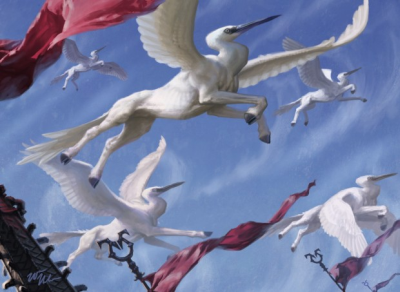
All three of these flying decks have me excited; I’m not going to be attending an Open Series event for a while, but I’ll be busy brewing for that event
until then. My money is on the final deck in some form, but crushing people with Dragons sure makes for a good time too.
How do you enjoy to take to the skies?


